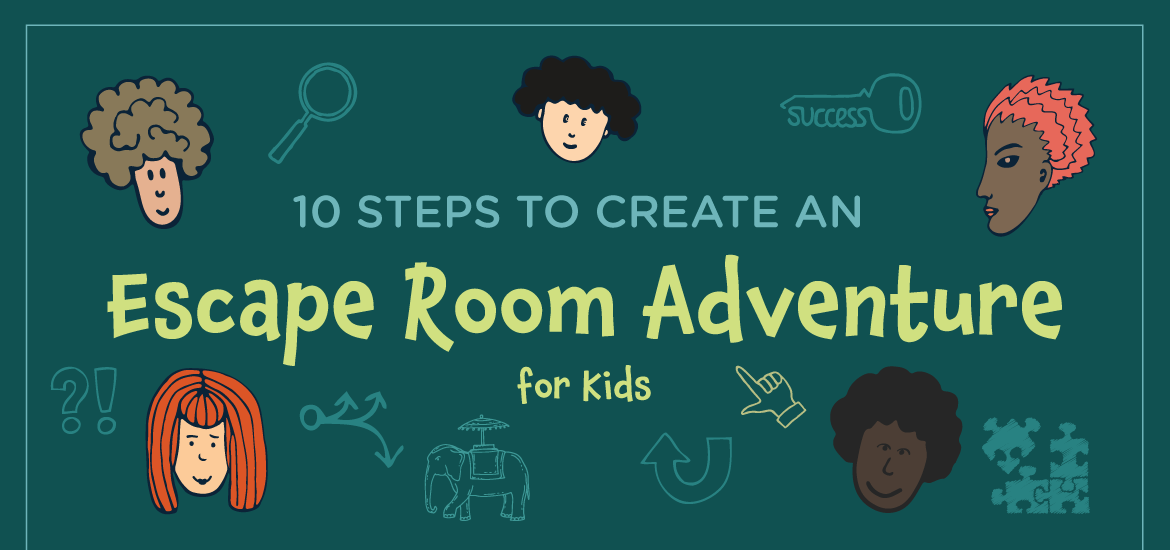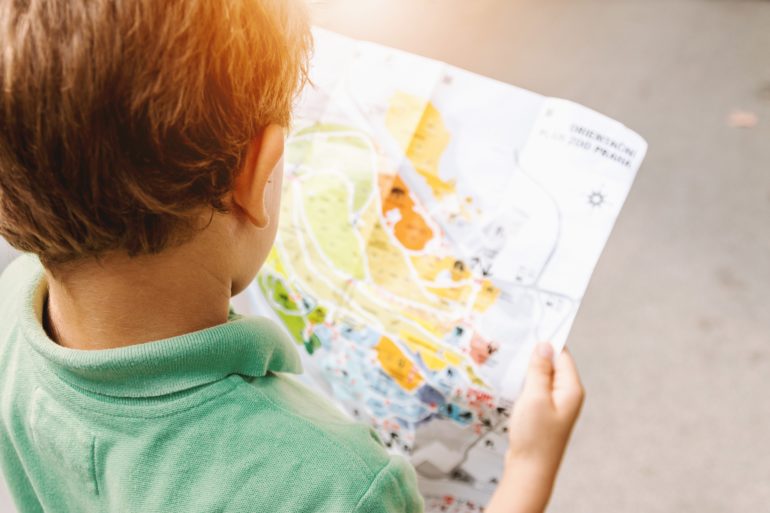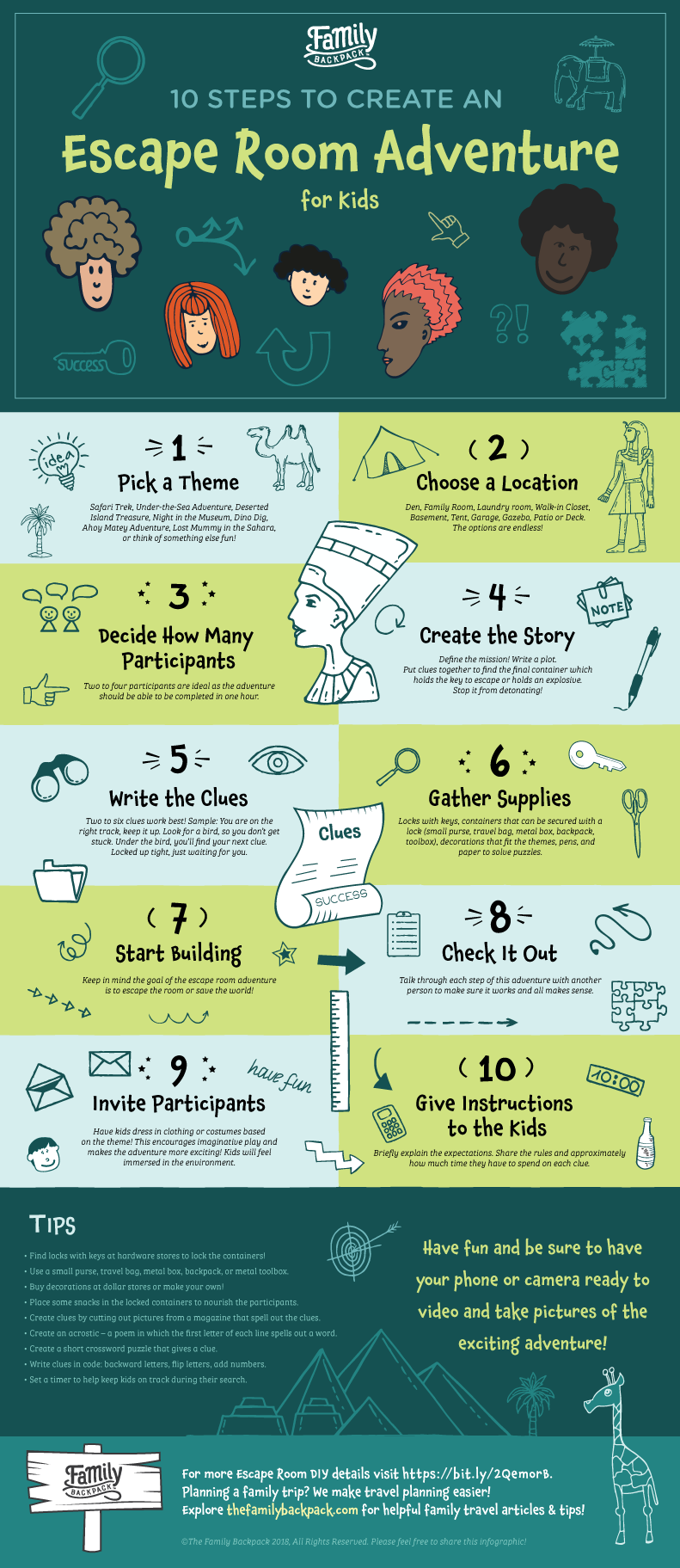Have you heard of escape rooms? They’re all the rage these days.
Perhaps you’ve done one with friends or co-workers at a team-building event.
Escape rooms are not only fun, but educational, and encourage kids to use their imagination. (Win-win!) We’re excited to share with you 10 steps on how you can create one yourself.
During seasons when your kids are in school and you may not be traveling as much, but you still want to create a travel mindset, consider creating an adventure for your kids through a fun, exploration-themed escape room in your own home. Escape rooms require creativity, problem-solving, and team-building. They encourage thinking outside the box!
Talking about traveling, adventures, and history with your kids helps them foster a love of travel and culture – and a DIY Escape room brings this to the next level.
You can create a DIY escape room adventure for your kids in just 10 easy steps.
- Pick a theme
Ideas:
- Safari Trek
- Under-the-Sea Adventure
- Deserted Island Treasure
- Night in the Museum
- Dino Dig
- Ahoy Matey Adventure
- Lost Mummy in the Sahara
Depending on the theme, start by writing down ten items that connect to that theme. You can use these items for decorating, help with the clues and get your escape room ideas started.
-
Determine the location of the escape room
Indoor ideas:
- Den
- Family room
- Laundry room
- Walk-in closet
- Basement
Outdoor ideas:
- Tent
- Cupola
- Garage
- Gazebo
- Patio or Deck
Decorate the space so that it closely resembles and feels like your chosen theme.
-
Decide the number of participants
Two to four participants are ideal as the adventure should be able to be completed in one hour. This allows kids, someone, to work with to decipher clues. Plus, a small group makes everything more fun!
-
Create the story
The plot for the story should come from the theme you choose. Write out your story including why the participants are in the escape room and their mission.
Mission: Put clues together to find the final container that holds the key to escape.
Note: the final container could house an explosive that needs to be destroyed instead of using a key to escape the room. Use your imagination on this final container and what you wish the participants to do.
Sample story for a Safari Trek Escape Room:
There is a very dangerous bomb planted in the Jungle in Africa. You must find the bomb and destroy it. You have one hour to complete this mission. If you do not destroy the bomb, all of the animals in Africa will be blown up.
In this box, you will find Safari hats. Please choose people to help you on your mission and give them a hat.
You will go to the Jungle. (down in the basement)
Look for Clue One to guide you. The clues will help lead you to the bomb.
Good luck! And remember – all of the animals are relying on you to survive!
-
Write the clues
Consider the ages of the participant(s) when writing the clues. Determine how many clues to create and the difficulty – much like a scavenger hunt. Be creative and develop clues that fit with your theme/story.
Sample clue (from an adventure safari trek designed for 7-10 year-olds):
You are on the right track, keep it up. Look for a bird, so you don’t get stuck.
Under the bird, you’ll find your next clue.
Locked up tight, just waiting for you.
-
Find containers that can be secured with a lock and key
Choose how many containers you wish the participants to unlock — 4, 5, or 6 works best. Each container will be locked and you will create clues as to where the key can be found to unlock each container containing a clue.
-
Keep in mind the goal of the escape room adventure is to escape the room or save the world
Some tips…
You can:
- Create clues by cutting out pictures from a magazine that spell out the clues.
- Create an acrostic — a poem in which the first letter of each line spells out a word.
- Create a short crossword puzzle that gives a clue.
- Write clues in code – backward letters, flip letters, insert numbers in-between letters.
-
Talk through each step of this adventure with another person
Discuss the following details with another person:
- Does the story sound logical?
- Are the clues and adventure doable for the age group?
- Can the adventure be completed within one hour?
- Can they figure it out and follow the clues?
-
Participants can dress in clothing/costumes based on the theme
Dressing in costumes or dress-up clothes helps to encourage imaginative play. It makes the adventure of the escape room that much more exciting! The kids will feel immersed in the environment or situation in which the game takes place.
-
Before the start of the adventure give each participant a short verbal or written intro which briefly explains the expectations
Share the rules and about how much time they have to spend on each clue. During the adventure in the escape room, you may need to be engaged with the kids throughout the game. It might be helpful to set a timer and help keep them on track during their search for clues and lock boxes.
Okay, you did it! You created an adventure escape room game. Congrats! Here are some other tips to help.
Tips & How To’s:
- Find locks with keys at hardware stores or big-box stores.
- Containers can be a small purse, travel bag, metal box, backpack, metal toolbox, etc.
- Remember you must be able to lock the containers with a lock.
- Buy decorations at dollar stores or online; create or make the decorations using items from your home or props from your lawn and garden.
- Place some snacks in the locked containers to nourish the participants.
- Have fun and be sure to have your phone/camera ready to video and take pictures of the exciting adventure!
Escape room adventures are exciting and a unique way to engage children.
These experiences offer a way to enjoy the benefits of travel and learning about history without leaving home.
Have you tried creating an escape room? If you do, share your adventure with us.
Pin this article for future DIY escape room fun. Or save this handy infographic on Pinterest! You can also download The Family Backpack Escape Room Adventure PDF!





